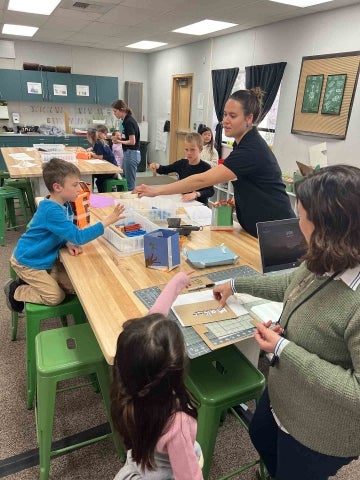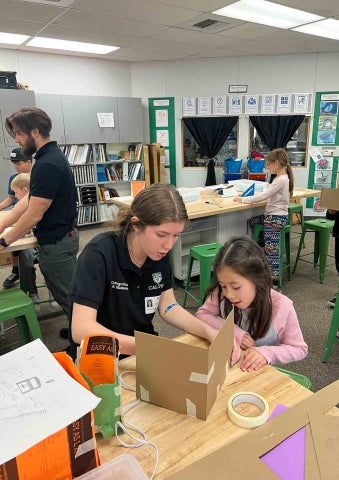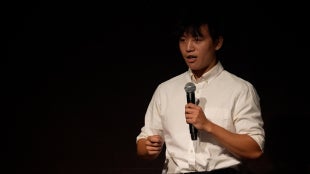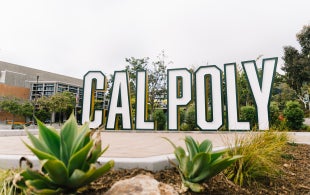Cal Poly Students Mentor Local Elementary School Children in STEM Projects Through Pilot Outreach Program
Contact: Nick Wilson
805-235-8008, nwilso28@calpoly.edu
SAN LUIS OBISPO — Through an initiative inspiring hands-on learning and science, technology, engineering and mathematics (STEM) education funded by the federal SciTrek program, Cal Poly students are mentoring pupils at San Luis Obispo County elementary schools by helping to develop lesson plans, working alongside teachers and assisting with workshops.

Photo by Cynthia Lambert, Cal Poly
The SciTrek pilot program involving Cal Poly students is in its first academic year, serving students at Fairgrove Elementary School in Grover Beach, part of Lucia Mar Unified School District, and Atascadero Unified’s Santa Margarita Elementary School.
The U.S. Department of Defense-funded SciTrek initiative, which compensates Cal Poly student mentors who include participants in Cal Poly’s Center for Engineering, Science and Mathematics Education (CESAME) program, are supporting the outreach. SciTrek provides paid, early-field experience offered each quarter for undergraduate students who want to work with kids or seek an experience to “try teaching.”
Cal Poly students also have participated at an afterschool Maker’s Club at Santa Margarita Elementary.
The goal of the SciTrek partnership is to give students who are thinking about careers as educators the opportunity to lead active, engaged participation while teaching concepts related to the scientific process, technology skill-building and experiential learning. The initiative aims to expand to additional Central Coast schools in future years.
Coordinators say the mentorship strengthens children’s confidence in STEM, especially among female and minority pupils, who are underrepresented in many STEM sectors. The STEM workforce currently includes 35% women, according to a report released earlier this year by the National Center for Science and Engineering Statistics — part of the National Science Foundation — and serves as a clearinghouse for the collection, interpretation, analysis, and dissemination of objective science and engineering data. Underrepresented minority groups make up nearly one in four (24%) of STEM workers.
“If we create better pathways into STEM for girls and underrepresented students, we elevate and raise everybody,” said Kurt Holland, a lecturer in Cal Poly’s School of Education.

Photo by Cynthia Lambert, Cal Poly
“Introducing STEM to elementary students is so important to close the achievement and gender gaps in the STEM fields and getting role models in front of little kids growing up,” said Caleb Unruh, a Maker’s Club mentor and recent Cal Poly graduate (Biological Sciences, '22). “Kids can start seeing themselves as a scientist or an engineer.”
To create the “The Perfect Maker’s Toolbox” afterschool project, 20 Santa Margarita elementary students who gather after school each Thursday recently designed containers for storing school supplies. They sketched out concepts, input models into the computer and brought them to life with the Glowforge 3D Laser Cutter, operated by adult supervisors.
The students used cardboards of different thicknesses, paper and thin wood. The toolkits were assembled using hot glue and decorated using colored markers and pencils. Then they presented their classmate with their finished work.
“I can tell the kids are happy to have their brains stimulated after school as opposed to the traditional afterschool care that is less structured and educational,” said Erika Rohlfes, a first-year second year liberal studies major from Redwood City, California, who is involved with the SciTrek program. “The children are given an outlet to express their creativity in the science world.”
School Maker’s Club coordinator Brook Black said the Cal Poly students bring educational experience and mentorship to the youngsters that “makes science seem desirable.”
“In this program, the children are going to buy into what they’re learning,” she said, “and they’re going to be making decisions about what’s true and what’s not true instead of just reading from textbook information.”
Outside of the SciTrek partnership, Black has participated in recent years in the Central Coast Science Project in partnership with Cal Poly faculty. That program helps teachers develop innovative science learning projects. Black has steadily developed and grown the Maker's Club program at her school over the past couple of years, which has been enhanced by the Cal Poly student involvement after the university mentors joined last winter.
The Maker’s Club classroom is well-equipped with furniture, tables, shelving and the laser printer that precisely cuts, engraves and scores cardboard, acrylic and wood for creative projects, all funded by Santa Margarita Elementary’s Parent Teacher Association.
Holland said that CESAME remains committed to maker’s spaces because “the idea of design challenges hits so many learning priorities, including student choice.”
“So instead of the teacher saying you’re going to do this, in this way, to be done by that time — which is boring — now children are engaged and connected to the application of learning because they have voice and choice,” Holland said.


